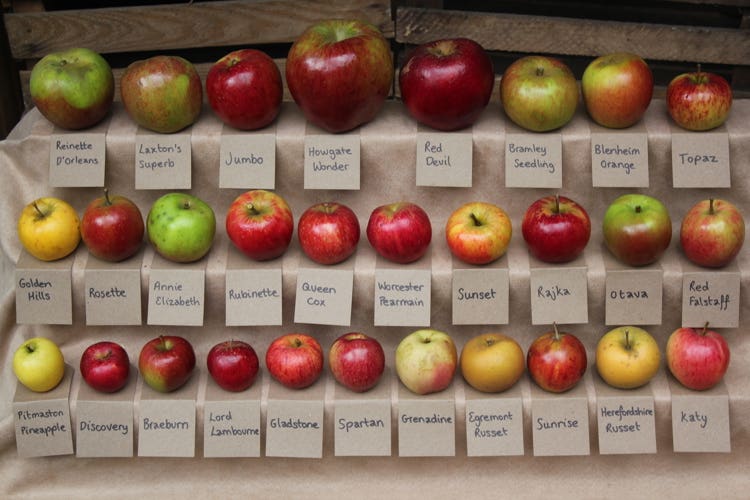New study reveals the evolution of apples across 60 million years
A new study has unlocked how wild and cultivated apples evolved, merged, and adapted through time.

A deep dive into apple genomes reveals how hybridization, duplication, and evolution shaped the fruit’s flavor, toughness, and diversity. (CREDIT: CC BY-SA 4.0)
In the temperate forests of the Northern Hemisphere, a quiet but powerful story has been unfolding for nearly 60 million years. It’s a story written in the DNA of a fruit so familiar that its history might seem simple—but the apple is anything but ordinary.
A new study has unlocked that complex history, peeling back genetic layers to show how wild and cultivated apples evolved, merged, and adapted through time.
An international research team, including scientists from Penn State, has built the most complete genetic map of apples and their wild cousins to date. This work reveals how apples diversified through hybridization, natural selection, and whole-genome duplications. It also uncovers genes tied to traits like flavor, disease resistance, and cold tolerance—traits that are key to breeding better apples in the future.
The findings, published in Nature Genetics, offer a blueprint for improving apples while protecting the genetic legacy of their wild relatives.
Mapping the Apple Family Tree
Until now, scientists had only scratched the surface of the apple’s genetic history. Most studies focused on a few cultivated varieties, leaving big gaps in our understanding of the broader Malus genus. This new study changes that by sequencing 30 high-quality genomes across the genus, including the popular ‘Golden Delicious’ apple and 29 wild species.
Of the 30 species examined, 20 are diploid, meaning they have two copies of each chromosome, much like humans. The other 10 are polyploid, with three or four copies. These extra copies likely came from recent hybrid events between species. By analyzing about 1,000 genes from each species, the team built a detailed family tree, tracing the origin of Malus back to East Asia around 56 million years ago.
Hong Ma, a professor of biology at Penn State and one of the lead researchers, explained the importance of this breakthrough.
Related Stories
“There are roughly 35 species in the genus Malus, but despite the importance of apple as a fruit crop, there hasn’t been extensive study of how this group’s genomes have evolved,” said Ma. “We were able to do a deep dive into the genomes, establish an apple family tree, document events like whole-genome duplications and hybridizations, and find regions of the genome associated with specific traits.”
The Power of Pan-Genomics
To better understand how these traits evolved, the team used a method called pan-genomics. This approach compares both the shared (or “core”) genes and the unique ones found in only a few species. It also looks at transposons—sometimes called jumping genes—that can move around and change the structure of the genome.
Instead of relying on a single reference genome, the scientists created a genome graph that combines all 30 species. This gave them a much clearer picture of how the genomes differ, especially in areas linked to traits like disease resistance and flavor.
“The use of the pan-genome of 30 species was powerful for detecting structural variation, as well as gene duplications and rearrangements, among the species that might be missed by comparisons of only a few genomes,” Ma said. “One of the uncovered structural variants allowed us to pinpoint the genome segment associated with resistance to apple scab, a fungal disease that impacts apples worldwide.”
This level of detail wasn’t possible with older genetic tools. The pan-genome allowed the team to explore subtle but important changes that can shape an apple’s traits—like its taste, appearance, and ability to withstand cold or disease.
The Cost of Tastier Apples
As apples became more delicious, some of their hardiness may have been lost. The researchers used their genome graph to track a process called a selective sweep. This is when a beneficial trait becomes more common in a population very quickly. In the case of apples, the team found that a gene region linked to cold resistance and disease resistance in wild species might also cause a bitter taste.
“It’s possible that in the efforts to produce the best tasting fruit, there was an inadvertent reduction of the hardiness of domesticated apples,” said Ma. “Understanding the structural variations in the Malus genomes, the relationships among the species and their history of hybridization using pan-genome analysis could help guide future breeding efforts so that the beneficial traits for good taste and disease-resistant can both be retained in apples.”
By better understanding where these genes are and how they interact, future breeders can avoid the trade-offs that came with earlier cultivation. This could lead to apples that don’t just taste great but are also tough enough to survive harsher climates and resist more pests.
A Complex Genetic Landscape
The apple genome has experienced whole-genome duplications (WGDs), where the entire genetic code was copied. These duplications are found not only in apples but in other flowering plants, fungi, and even animals. WGDs often provide raw material for evolution, creating extra gene copies that can take on new roles or adapt in different ways.
In apples, an ancient duplication event created many gene pairs that still exist today. By studying these pairs across 30 species, scientists can see which ones were preserved and which ones evolved new functions. This helps them understand how the apple’s traits came to be.
“The evolutionary history of the genus is quite complex, with numerous examples of hybridization between species and a shared whole-genome duplication event that make comparisons difficult,” Ma said. “Having high-quality genomes for such a large number of the species in the genus and understanding the relationships among them allowed us to dig deeper into how the genus has evolved.”
Many of these evolutionary changes wouldn’t be visible without this multi-species comparison. Using only the genome from domesticated apples would miss key genetic differences that come from wild relatives.
Wild Roots, New Futures
The apple as we know it today came from Malus sieversii, a species native to Central Asia. But its journey to grocery stores around the world also involved genes from M. orientalis and M. sylvestris, thanks to hybridization. Over time, most commercial apple orchards began to rely on just a few closely related cultivars. While this made production more predictable, it also narrowed the gene pool.
That’s where wild apples come in. They still carry a wide variety of genetic tools—resistance to frost, pests, and drought—that may be missing in cultivated varieties. By mapping these genes and understanding their function, scientists now have a clearer path to bring those benefits back.
Despite earlier advances in apple genome studies, much of the genetic diversity across the Malus genus had been left out. This new research provides a more complete view of how different apple species evolved and adapted, both on their own and through hybridization. It also reveals how polyploidy—having extra chromosome sets—has contributed to species diversity and environmental adaptation.
“This study finally gives us the high-resolution genomic tools to understand what’s been going on under the surface for millions of years,” said postdoctoral researcher Taikui Zhang, who worked alongside Ma at Penn State. “With these tools, we can start making smarter decisions in breeding that preserve both the taste and the toughness of apples.”
Their work was supported by Penn State’s Eberly College of Science and the Huck Institutes of the Life Sciences. Other collaborators and funding sources are listed in the published paper.
Research findings are available online in the journal Nature Genetics.
Note: The article above provided above by The Brighter Side of News.
Like these kind of feel good stories? Get The Brighter Side of News' newsletter.
Rebecca Shavit
Science & Technology Journalist | Innovation Storyteller
Based in Los Angeles, Rebecca Shavit is a dedicated science and technology journalist who writes for The Brighter Side of News, an online publication committed to highlighting positive and transformative stories from around the world. With a passion for uncovering groundbreaking discoveries and innovations, she brings to light the scientific advancements shaping a better future. Her reporting spans a wide range of topics, from cutting-edge medical breakthroughs and artificial intelligence to green technology and space exploration. With a keen ability to translate complex concepts into engaging and accessible stories, she makes science and innovation relatable to a broad audience.



